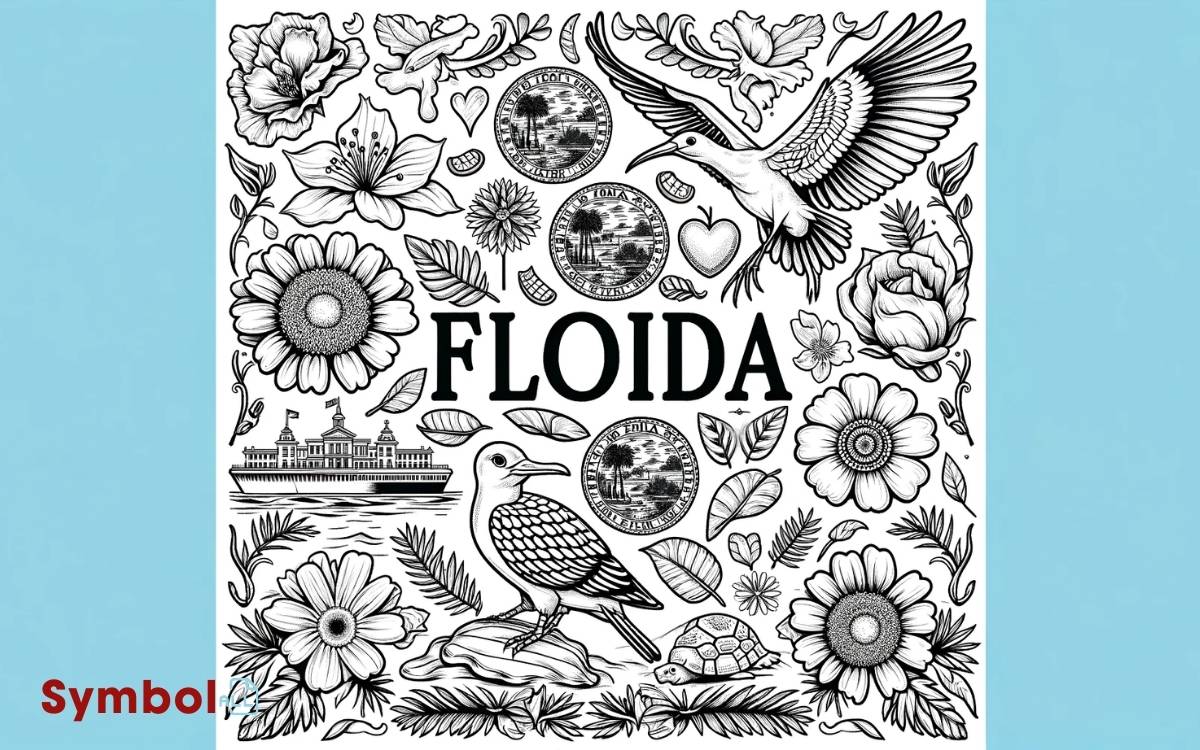Florida State Symbols Coloring Pages: Explains!
Looking for Florida State Symbols coloring pages? You’re in luck! Bring the majestic Florida Panther, with its piercing gaze, to life with your colors.
Don’t forget the Orange Blossom, Florida’s fragrant state flower, symbolizing the state’s citrus industry. The enchanting Mockingbird, known for its varied song, and the powerful American Alligator, a key player in Florida’s ecosystem, also await your artistic touch.
And of course, the Sabal Palm‘s resilient beauty is a must-color. Each page is a chance to celebrate and learn about Florida’s diverse symbols. Dive deeper, and you’ll discover more intriguing facts and figures.

Key Takeaways
10 Florida State Symbols Coloring Pages
| Symbol | Category | Description |
|---|---|---|
| American Alligator | State Reptile | A large reptile found in freshwater environments of Florida. |
| Orange Blossom | State Flower | The fragrant blossom of the orange tree, representing Florida’s citrus industry. |
| Mockingbird | State Bird | Known for its ability to mimic the calls of other birds, it’s a common sight in Florida. |
| Sabal Palm | State Tree | Also known as the cabbage palm, it’s a symbol of the Florida landscape. |
| Florida Panther | State Animal | A rare subspecies of puma that lives in the forests and swamps of southern Florida. |
| Manatee | State Marine Mammal | Gentle giants found in Florida’s springs and warm water sites. |
| Dolphin | State Saltwater Mammal | Intelligent and playful creatures commonly seen off the Florida coast. |
| Largemouth Bass | State Freshwater Fish | A popular fish among anglers, found in Florida’s lakes and rivers. |
| Moonstone | State Gem | Not naturally occurring in Florida, but it represents the state’s role in space exploration. |
| Zebra Longwing Butterfly | State Butterfly | Characterized by its long black wings with bold yellow stripes. |
Florida Panther
Did you know that the Florida Panther, a symbol of wild grace and power, is one of the Sunshine State’s most iconic symbols?
This majestic animal, with its tawny coat and piercing gaze, roams the forests and swamps of Florida, embodying the untamed beauty of the state’s natural landscape.
As the official state animal since 1982, it plays an essential role in Florida’s ecosystem, controlling the population of other species and maintaining the balance of nature.
Sadly, it’s also one of the most endangered mammals in the U.S., with habitat loss and collisions with vehicles posing significant threats to its survival.
Orange Blossom
Wafting through the air, the sweet scent of the Orange Blossom, Florida’s state flower, invites you to explore the rich tapestry of the state’s flora.
Adopted in 1909, this fragrant bloom symbolizes the state’s abundant citrus industry. With its delicate white petals and vibrant green leaves, the orange blossom isn’t just a feast for the nose; it’s a visual treat too.
Its significance isn’t merely vital; the orange blossom plays an essential role in local ecosystems, attracting pollinators like bees.
As you color in your Florida State Symbols Coloring Pages, remember you’re not just filling in any flower. You’re bringing to life a symbol of Florida’s natural beauty, economic strength, and ecological importance.
Let each stroke of color celebrate the orange blossom’s enduring charm.
Mockingbird
As you turn the page, you’ll find the Mockingbird, Florida’s state bird, known for its enchanting song that echoes the sounds of many other birds.
With its sleek gray feathers and distinct white patches, this bird not only captivates with its appearance but also with its melodious tunes.
As you color, imagine the Mockingbird perched on an orange blossom, serenading the sunny skies of Florida with a symphony of songs.
| Feature | Description | Symbolism |
|---|---|---|
| Color | Gray body with white patches | Elegance and simplicity |
| Song | Mimics other birds | Diversity and adaptability |
| Habitat | Across Florida | Ubiquity and resilience |
| Significance | State bird since 1927 | Enduring Florida heritage |
Through your coloring, you’re not just bringing to life Florida’s natural beauty but also celebrating its rich, vibrant culture.
American Alligator
Next up on our coloring adventure, you’ll meet the American Alligator, a remarkable resident of Florida’s waterways.
You’ll learn about its diverse habitats, what it loves to eat, and how it hunts, alongside the crucial conservation efforts that protect these ancient creatures.
Let’s grab our crayons and explore the world of these fascinating predators, coloring our way through their lives and the initiatives ensuring their future.
Alligator Habitat Zones
American alligators primarily inhabit freshwater environments across the southeastern United States, including swamps, rivers, and lakes.
These powerful reptiles have adapted to a variety of habitats, making them a fascinating subject for your coloring adventures.
Let’s immerse ourselves into the zones where you can commonly find these majestic creatures.
| Habitat Type | Location | Characteristics |
|---|---|---|
| Swamps | Florida, Louisiana | Dense vegetation, murky waters |
| Rivers | Mississippi, Alabama | Flowing freshwater, banks |
| Lakes | Texas, Georgia | Open waters, marshy edges |
| Marshes | South Carolina | Wetlands, reed-filled areas |
Each habitat presents a unique backdrop for the American alligator, showcasing their adaptability and the rich biodiversity of the southeastern U.S.
Immerse yourself in your coloring project with this knowledge, bringing these habitats to life with your creativity.
Diet and Hunting Patterns
Diving into the diet and hunting patterns of the alligator reveals a fascinating aspect of their survival in the wild. These formidable predators aren’t picky eaters. They’ll consume fish, birds, and even mammals, adapting their diet based on what’s available.
As opportunistic hunters, alligators often wait patiently, partially submerged, before launching a surprise attack on their prey. They rely on their powerful jaws to catch and crush their meals, sometimes storing larger kills to soften before eating.
You’d be intrigued to know that alligators also play an essential role in their ecosystem by controlling the population of certain prey species.
This balance helps maintain a healthy environment in Florida’s wetlands, showcasing the alligator’s importance beyond its fearsome reputation.
Conservation Efforts Today
The alligator’s journey from the brink of extinction showcases the power of dedicated conservation efforts in protecting these magnificent creatures.
In the late 20th century, the American alligator was facing dire threats from habitat loss, hunting, and pollution.
Recognizing the urgent need for action, conservationists and government agencies rallied to put protective measures in place.
Today, you’ll find that laws strictly regulate alligator hunting, ensuring their populations remain stable. Protected habitats have been established, giving alligators safe havens to thrive.
Additionally, public education programs have played an essential role in changing perceptions, promoting coexistence between humans and alligators.
Thanks to these concerted efforts, alligators have made a remarkable comeback, symbolizing hope for other endangered species.
Sabal Palm
Next up is the Sabal Palm, a symbol deeply rooted in Florida’s identity. You’ll learn how to recognize this iconic tree, along with practical advice on its growth and care.
We’ll also explore its significant place in Florida’s heritage, adding depth to your coloring experience.
Sabal Palm Identification
How can you identify a Sabal Palm, Florida’s esteemed state tree? Recognizing this iconic symbol is simpler than you might think.
Here’s a quick guide:
| Feature | Description | Note |
|---|---|---|
| Leaves | Fan-shaped | Large, up to 5-6 feet across |
| Trunk | Tall, slender | Grayish-brown, smooth in mature trees |
| Flowers | Creamy white | Small, clustering on long stalks |
The Sabal Palm, also known as the Cabbage Palm, stands out with its grand leaves that fan out from a single point, creating a striking silhouette against the Florida skyline.
Its trunk, which can grow impressively tall, often remains smooth as the tree matures. In spring and summer, look for the delicate creamy white flowers that add an extra layer of beauty to this already magnificent tree.
Growth and Care Tips
Caring for a Sabal Palm, despite its grand appearance, is surprisingly straightforward and rewarding. These iconic trees can add a touch of Florida charm to your landscape with the right approach.
Here’s how you can guarantee your Sabal Palm thrives:
- Sunlight: Guarantee your palm gets plenty of sunlight. They love full sun exposures.
- Watering: Regularly water young palms; mature ones are drought-tolerant but appreciate occasional watering during dry spells.
- Soil: Plant in well-draining soil. Sabal Palms aren’t fussy about soil types but dislike waterlogged conditions.
- Fertilization: Feed your palm a balanced, slow-release palm fertilizer during the growing season to support its health and growth.
With these tips, you’ll find maintaining a Sabal Palm is rewarding and adds a majestic touch to your space.
Symbolic Meaning in Florida
The Sabal Palm, standing tall and proud, symbolizes resilience and beauty across Florida, embodying the state’s spirit and natural charm.
As you’re exploring the Sunshine State, you’ll notice this majestic tree gracing landscapes from beaches to wetlands, a validation to its adaptability and strength.
It’s not just a tree; it’s a symbol of Florida’s ability to thrive despite hurricanes and storms. The Sabal Palm, also recognized as the state tree, mirrors the enduring qualities of Floridians themselves – resilience, beauty, and a deep connection to their environment.
As you color in the Sabal Palm on your Florida State Symbols coloring pages, remember you’re bringing to life a piece of Florida’s heart and soul, a true emblem of perseverance and natural beauty.
Manatee
Glide into the serene waters of Florida, and you might spot a manatee, the state’s gentle aquatic giant, gracefully moving through its habitats. Often called ‘sea cows,’ these peaceful creatures are a beloved symbol of Florida’s diverse wildlife.
Here’s why they’re so fascinating:
- Herbivores at Heart: Manatees munch on water plants, spending up to eight hours a day feeding.
- Gentle Giants: Despite their large size, manatees are known for their calm demeanor.
- Warm-Water Lovers: They prefer waters above 68°F, which makes Florida’s springs and rivers perfect.
- Close Cousins: Manatees are related to elephants, sharing a similar gentle nature and slow reproduction rate.
Understanding manatees enriches your appreciation of Florida’s natural beauty and the importance of preserving it for future generations.
Key Lime Pie
Next up, let’s explore Key Lime Pie, a delicious symbol of Florida. You’ll learn about its tart beginnings, the must-have ingredients that make it a classic, and how best to serve this citrusy dessert.
Whether you’re a baking novice or an experienced cook, these insights will enhance your appreciation for this beloved state treasure.
Key Lime Origins
Originating from the Florida Keys, Key lime pie has become a beloved dessert, symbolizing the state’s rich culinary heritage. This tangy treat has an interesting backstory that’s as flavorful as the pie itself.
Here’s a quick bite of its origins:
- Key limes themselves were introduced to the Florida Keys in the early 20th century, quickly becoming a local staple.
- The exact origins are debated, but many believe the pie was first created by sponge fishermen who’d limited cooking resources.
- Condensed milk played a key role, as refrigeration was scarce, leading to the invention of a no-bake filling.
- Finally, graham cracker crust and meringue topping became the norm, solidifying Key lime pie as Florida’s signature dessert.
Recipe Essentials
Having explored the rich history behind Key lime pie, let’s now focus on what you’ll need to make this iconic dessert yourself.
At its core, Key lime pie requires just a few essential ingredients. In the first place, you’ll need Key lime juice, which gives the pie its unique tart flavor.
If you can’t find fresh Key limes, bottled juice works as well. Next, sweetened condensed milk and egg yolks are vital for the creamy filling, blending perfectly with the acidity of the lime. For the crust, graham crackers, melted butter, and sugar will do the trick.
These simple, yet specific ingredients come together to create a dessert that’s both tangy and sweet, embodying the spirit of Florida in every bite.
Serving Suggestions
Once you’ve mastered the art of making Key lime pie, you’ll find there are numerous delightful ways to serve this tangy dessert that can enhance its flavors and presentation.
- Garnish with Fresh Whipped Cream: A dollop of freshly whipped cream on top adds a creamy texture that perfectly complements the pie’s tanginess.
- Add a Lime Twist: A twist of lime peel not only looks elegant but also gives a hint of lime aroma to excite the senses before the first bite.
- Serve with Berry Compote: The sweetness of berries pairs wonderfully with the tartness of the Key lime, offering a balanced flavor profile.
- Dust with Powdered Sugar: A light dusting of powdered sugar right before serving can add a subtle sweetness and a professional touch to your Key lime pie presentation.
Largemouth Bass
The Largemouth Bass, Florida’s celebrated freshwater fish, offers anglers thrilling catches and stands as a symbol of aquatic prowess.
Recognized for its distinctive dark stripe running horizontally along its flank, this species thrives in the state’s diverse freshwater habitats. You’ll find them lurking in everything from clear springs to murky ponds, always on the hunt for their next meal.
Their voracious appetite makes them a favorite among fishermen, who often recount tales of the bass’s impressive jumps and fights when hooked.
Coloring pages featuring the Largemouth Bass not only celebrate this spirited fish but also encourage a deeper appreciation for Florida’s natural aquatic environments.
As you color, imagine the serene beauty of Florida’s waters and the excitement of reeling in one of these magnificent creatures.
Florida Cracker Horse
Galloping through Florida’s history, the Cracker Horse, a symbol of pioneering spirit, awaits your discovery on the next coloring page. This unique breed has a rich legacy that’s as vibrant as the colors you’ll choose to bring it to life.
Here’s what makes the Florida Cracker Horse stand out:
- Heritage: Descendants of Spanish horses, they’ve roamed Florida since the 16th century.
- Survival Skills: Adapted to thrive in Florida’s rough terrain and climate.
- Work Ethic: Historically used by cowboys for cattle herding, showcasing their agility and endurance.
- Preservation: A symbol of Florida’s commitment to preserving its agricultural history and biodiversity.
As you color, imagine the untamed lands and pioneering days this resilient horse has witnessed.
Coral Reef
Plunge into the vibrant world of Florida’s coral reefs, where you’ll explore an underwater ecosystem teeming with life and color.
These reefs aren’t just beautiful natural wonders; they’re also essential for the health of our oceans. Acting as natural barriers, they protect coastlines from storms and erosion.
You’ll find a diverse array of marine life here, from the tiny, colorful fish darting among the corals to the more majestic sea turtles gliding gracefully.
Each organism plays a pivotal role in the reef’s survival, contributing to a delicate balance that’s been perfected over millennia.
Coloring these pages, you’ll not only celebrate Florida’s natural beauty but also learn about the importance of preserving these underwater treasures for future generations to marvel at and enjoy.
Space Shuttle
Why not embark on a thrilling journey through the stars with Florida’s iconic Space Shuttle, a marvel of human ingenuity and a tribute to our quest for exploration?
Here are four enthralling insights:
- Launch Site: The Space Shuttle launches from the Kennedy Space Center, a cornerstone of America’s space program located on Florida’s east coast.
- Missions: It’s completed over 130 missions, including deploying satellites, interplanetary probes, and the Hubble Space Telescope.
- Innovation: This reusable spacecraft revolutionized space travel with its ability to return to Earth and fly again.
- Legacy: Though the program concluded in 2011, its legacy lives on, inspiring advancements in space exploration and technology.
Dive into the excitement of space exploration with the Space Shuttle, a symbol of Florida’s significant contribution to reaching beyond our world.
Atlantic Dolphin
As you explore the Atlantic Dolphin, you’ll uncover the captivating domains where they thrive, showcasing their diverse habitats.
You’ll be captivated by their unique behaviors, from their playful antics to their complex communication methods.
Additionally, you’ll learn about the crucial conservation efforts in place to protect these beloved marine mammals.
Dolphin Habitat Exploration
Exploring the habitat of the Atlantic dolphin reveals a dynamic environment where these intelligent creatures thrive in the warm waters of the Atlantic Ocean. Their homes aren’t just vast open waters; they’re intricate ecosystems crucial for their survival.
Here’s what makes their habitat so special:
- Temperature Regulation: The Atlantic Ocean’s warm currents provide the perfect temperature for dolphins, ensuring they stay comfortable year-round.
- Food Abundance: Rich in fish and squid, these waters offer dolphins a varied diet, essential for their energy needs.
- Safety in Numbers: Dolphins often form large groups, or pods, using the vast ocean space to their advantage for protection against predators.
- Breeding Grounds: The ocean’s expansive, secluded areas serve as ideal spots for mating and raising their young, away from threats.
Unique Behaviors Unveiled
Diving into the world of Atlantic dolphins reveals a fascinating range of behaviors that showcase their intelligence and adaptability.
You’ll find they’re not just playful; they’re strategic hunters and communicators. They use echolocation, bouncing sound waves off objects to locate prey and navigate the murky waters.
They’re also known for their complex social structures, forming tight-knit groups called pods, where they engage in cooperative hunting and even babysitting each other’s young.
What’s more, Atlantic dolphins have a unique way of using tools. They’ll often use sea sponges to protect their snouts while foraging on the ocean floor.
These behaviors don’t just highlight their smarts; they underline the dolphins’ ability to adapt and thrive in their ever-changing environment.
Conservation Efforts Highlighted
In recent years, concerted efforts have been made to protect the Atlantic dolphin, highlighting the critical need for conservation to safeguard these intelligent marine mammals.
Here are four key actions that have been undertaken:
- Establishing Protected Marine Areas: This guarantees dolphins have safe habitats free from human interference and pollution.
- Implementing Sustainable Fishing Practices: Reducing bycatch helps prevent accidental dolphin catches.
- Promoting Public Education: Awareness campaigns educate people on how their actions can impact dolphin populations.
- Supporting Research Initiatives: Funding studies give us better insights into dolphin behavior and health, guiding conservation strategies.
Loggerhead Turtle
You’ll discover the loggerhead turtle, a beloved symbol of Florida’s marine life, known for its large head and powerful jaws. These majestic creatures aren’t just a sight to behold but also play an important role in the marine ecosystem.
They’re primarily found in the warm waters of the Atlantic, Pacific, and Indian Oceans, with Florida’s beaches serving as significant nesting sites.
Loggerheads are known for their long migrations across oceans, a journey that fascinates scientists and conservationists alike.
As you color in the loggerhead turtle on your Florida State Symbols coloring page, remember these turtles are both resilient and vulnerable.
Their survival depends greatly on human actions, from protecting their nesting beaches to limiting plastic waste in our oceans.
Sunshine Skyway Bridge
Shifting our focus from the natural wonders beneath the waves, let’s explore the Sunshine Skyway Bridge, an architectural marvel that spans the mouth of Tampa Bay.
Standing tall as a proof of human ingenuity, this bridge isn’t just a way to get from point A to point B; it’s a journey over the sparkling waters of Florida.
Here are four fascinating facts about it:
- Iconic Design: Its cable-stayed design makes it a picturesque landmark, easily recognizable against the Florida skyline.
- Engineering Feat: Completed in 1987, it showcases advancements in construction and design.
- Lengthy Span: Stretching 4.1 miles, it’s an awe-inspiring sight for drivers and passengers alike.
- Safety First: After its predecessor’s tragic collapse in 1980, the new bridge was built with safety as a top priority.
Designed not just for utility but also for beauty, the Sunshine Skyway Bridge is a must-see for anyone visiting Florida.
Conclusion
As you bring these symbols to life with your colors, remember, you’re not just filling in pages. You’re journeying through Florida’s soul, from the stealthy panther in its forests to the majestic Space Shuttle piercing the heavens.
Each stroke of your crayon is a whisper of Florida’s diverse story a dance of nature and human achievement. So, let your imagination soar like the Atlantic Dolphin, for in your hands, Florida’s essence unfolds, a vivid tapestry woven from dreams and reality.






